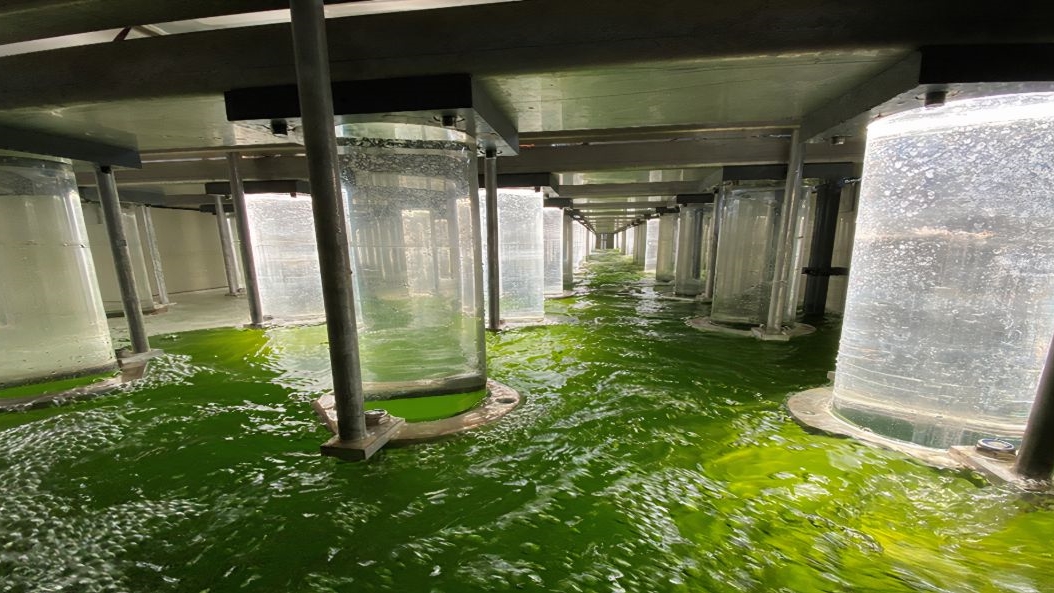Using Algae to Treat Water
I-Phyc takes a holistic approach to wastewater treatment that uses algae to deal with phosphate, ammonia, heavy metals, pharmaceuticals, and other potential pollutants. In the case of phosphate removal, I-Phyc’s algae cells are primed to do the job in eight hours; down from the more typical eight days that other approaches require. This is critical to treat ongoing flows of wastewater; it’s not sustainable to have lots of massive tanks storing water until treatment processes are ready. This is particularly the case for small treatment works where there are often space constraints.
Unlike chemical approaches to water treatment, such as those that use ferric sulphate, I-Phyc’s process produces valuable biomass as a by-product. And this is done without compromising on performance. It has been shown that Bio-P removal can remove phosphorus in wastewater to well below existing limits – this isn’t always the case with ferric sulphate. In fact, in lab tests and simulations, I-Phyc’s process has been shown to remove almost all phosphorus to trace levels, thus futureproofing the technology against any future, stricter legislation.
There is a misconception that the biomass is a waste product. This couldn’t be further from the truth. Let me explain.
Algae and the Carbon Question
I-Phyc’s algae can do so much; they are adaptable and flexible. As well as phosphorus, they absorb carbon dioxide. Every tonne of algae biomass takes in 1.83 tonnes of carbon dioxide. This is a clear benefit to the process. But then we must ask the question, should we sequester the carbon or use it and offset other carbon sources? What is the best approach to take in the race to Net Zero?
Sequestering Carbon
If we are to go down the sequestration route the biomass can be made into building materials, algae can be integrated into cement, fillers, resins or plastics. These are interesting applications, but ultimately, they are low-value options. That said, they can provide an added stream of revenue for wastewater companies.
Offsetting Carbon
The applications of the biomass for offsetting carbon are pretty endless – and this is where it gets really exciting. Take ink; for years, printer cartridge and toner companies have been reliant on petrochemicals to create black ink. But high-carbon algae can be processed for use in jet printer cartridges. Not only is this more environmentally friendly, but it also produces ink that is blacker than standard petroleum ink.
Algae can be used to help produce biochemicals, such as biodiesel. This offsets the damage done by petroleum diesel, which contains sulphur and carcinogenic benzene, for example. Biodiesel is nontoxic and biodegradable. Certainly, with geopolitical tensions in Ukraine and the Middle East, it would pay to have a source of biochemicals in the northern hemisphere to create a more stable supply chain.
The proteins in algae can be used in the agriculture sector, in animal feed and in dairy farming. Supplementing standard cow feed with algae proteins can reduce methane emissions and giving it to chickens results in more nutritious eggs.
Algae biofertiliser supplies a beautiful, complex nutrient profile, and it comes with the added benefit of offsetting carbon at the same time. The production of one tonne of standard fertiliser creates 1.3 tonnes of carbon dioxide. On the other hand, one tonne of algae-based biofertiliser captures 1.83 tonnes of carbon.
The list of potential uses goes on, but you get the picture – the applications for algae biomass are really valuable.
Raising Awareness
Consumers are more aware of what goes into the products they buy than ever before. Nowadays, people are eco-conscious and they want to buy from and do business with sustainable companies.
With this in mind, we want it to be as easy as possible for businesses across all industries to reap the benefits of algae. This involves getting rid of the perception that algae are just a waste product.
The drive from companies exists to go green but we need to do as much as we can to help them get there. A starting point would be raising awareness for algae’s perception to be incorporated into different products.
A Final Word
Algae has limitless potential. The good news is that wastewater companies are waking up to its ability to treat waters effectively while leaving a by-product that can change the world. This is not an exaggeration – right now, studies are exploring its potential to reduce the effects of HIV, plus treat blindness, diabetes and heart conditions.
We all want to build a better future and the wastewater industry can do just that by ditching chemicals and harnessing the power of algae.



